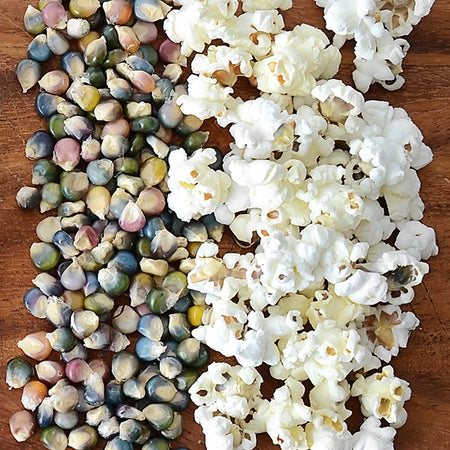GLASS GEM
Product Description:
| Soil Temp for Germ | 65–85°F |
| Seed Depth | 1–2" |
| Seed Spacing | 4" |
| Days to Emergence | 7–14 |
| Thin Plants to | 8–12" |
| Row Spacing | 24–30" |
| Fertilizer Needs | High |
| Minimum Germination | 80% |
| Seeds per Ounce | ≈ 110–250 |
| Seed Life | 1 year |
Zea mays
Days to maturity are calculated from date of direct seeding.
Hybrid SE/se Corn: The inherited sugar enhanced (SE/se) traits are what make these corn varieties unique. For starters, the kernel walls are the most tender of all corn varieties. Added to that are more sugars, making every ear as sweet as can be. After harvest, the conversion from sugar to starch in SE/se corn is delayed, so the corn maintains its sweetness longer after picking. To top it off, no isolation is required from other normal types of sweet corn, making SE/se corn very popular. For best germination, soil temperature should be at least 70°F.
Hybrid sh2 Supersweet Corn: The shrunken gene (sh2) gives the dried kernels an extra-wrinkled appearance. This inherited characteristic increases the sweetness of the corn at harvest time. Commonly called Supersweet, sh2 varieties are some of the sweetest corn available. They do not germinate well in cold wet soil, so make sure your soil is at least 70°F; use a soil thermometer if uncertain. To grow great Supersweet corn, isolate it by time or distance from any other corn.
OP Sweet Corn: For best seed saving results we recommend bagging plants to avoid cross pollination.
Ornamental Corn: Often used for decorating, but it also makes great cornmeal and corn flour. Grow just as you do sweet corn. The earliest plantings are preferred to ensure ample time for field drying. Ears may be picked after the husks begin drying. Isolation is necessary between varieties to preserve color combinations.
Popcorn: After picking and husking, spread the ears in a dry, airy place and allow to cure for several weeks. Test-pop a few kernels periodically to determine when the kernels are dry enough to make into popcorn. Twist the kernels from the cobs and store in airtight containers. Large quantities can be processed by placing into heaps and stomping the kernels off the ears. For best results, isolate from any other corn.
Synergistic Corn: Synergistic corn has 75% sugar enhanced kernels and 25% Supersweet kernels. It combines the exceptional tenderness and sweet corn flavor of SE/se varieties with the extra sweetness, extended shelf life and field-holding ability of sh2 varieties. For best results, isolate Synergistic corn from any other corn. For best germination, soil temperature should be at least 70°F.
Culture
• Corn performs best in fertile, well-drained soil with a pH between 6.0-7.0
• Corn is a heavy feeder requiring high amounts of nitrogen during the vegetative stage
• Waiting for soil to reach optimum temperature is critical to successful corn growing
• Corn is wind pollinated - for proper pollination plant individual varieties in blocks of at least 4 rows
• Separate varieties by time (plant 10 days apart), or distance (200 feet) to reduce cross-pollination
• For optimum growth ensure beds are watered evenly and deeply
Direct Sowing
• Make row furrows about 6-8 inches deep
• Spread 3-5 pounds of TSC's Complete fertilizer per 100 square feet
• Back fill the furrow, then sow seeds and cover with soil or sifted compost
• Thin seedlings when 4-5 inches
Transplanting
• Start indoors 2-3 weeks before desired transplant date
• Avoid letting starts get root bound and avoid damaging roots when planting
Insects & Diseases
• Common insects: Corn borer, corn ear worm
• Insect control: Pyrethrin, applied before silking, Monterey B.t. to silks
• Common diseases: Blight, rust, smut
• Disease prevention: 3-4 year crop rotation, remove old stalks in the fall, and contact your local extension agent with specific issues
Harvest & Storage
• Harvest when kernels are full and milky
• Drying and browning of ear silks is also an indicator of maturity
• Ears should be cooled as quickly as possible and stored at 36°F
KEY TO CORN DISEASE RESISTANCE AND TOLERANCE
HR indicates high resistance.
IR indicates intermediate resistance.
MDMV | Maize Dwarf Mosaic Virus
NCLB | Northern Corn Leaf Blight
R | Common Rust
SCLB | Southern Corn Leaf Blight
SW | Stewart's Wilt




